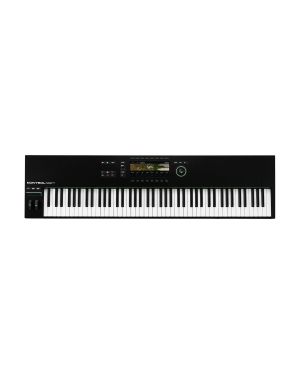
-
![Native Instruments Kontrol S61 MK3]() In Stock
In Stock -
Special Offer
![Trumix MC-25BT Midi Controller]() In Stock
In Stock -
![Native Instruments Kontrol S88 MK3]() In Stock
In Stock -
![Buchla LEM218 V3 Touchplate Controller Keyboard]() In Stock
In Stock -
![Native Instruments Kontrol S49 MK3]() In Stock
In Stock -
![Arturia Keylab MK3 49 Midi Keyboard - Black]() In Stock
In Stock -
![Novation Launchkey 25 Mini-Key MK4 Compact MIDI Controller Keyboard]() In Stock
In Stock -
![Arturia Keylab Essential 3 - 49 Key White]() In Stock
In Stock -
![AKAI Professional MPC Key 37 MIDI Keyboard]() In Stock
In Stock -
![Novation 49 SL MkIII USB MIDI Keyboard Controller]() In Stock
In Stock -
Free Software
![Native Instruments Komplete Kontrol A61]() In Stock
In Stock -
![Arturia Keylab Essential 3 - 49 Key Black]() In Stock
In Stock -
New Release
![Arturia Keylab MK3 61 Midi Keyboard - Black]() In Stock
In Stock -
![Akai MPK Mini Play MK3 Mini Controller Keyboard]() In Stock
In Stock -
New Release
![Arturia Keylab MK3 49 Midi Keyboard - White]() In Stock
In Stock -
![Novation Launchkey 37 Mini-Key MK4 Compact MIDI Controller Keyboard]() In Stock
In Stock -
![Novation 61 SL MkIII USB MIDI Keyboard Controller]() In Stock
In Stock -
In Stock
-
![Arturia KeyLab Essential 49 Mk3 Limited Edition Alpine White]() In Stock
In Stock -
![M-Audio Oxygen Pro Mini USB MIDI Controller]() In Stock
In Stock -
Free Software
![Native Instruments Komplete Kontrol M32 Keyboard]() In Stock
In Stock -
![M-Audio Hammer 88 USB MIDI Keyboard Controller]() In Stock
In Stock -
![Arturia Keystep MIDI Keyboard Controller]() In Stock
In Stock -
![Korg Keystage 49 MIDI Keyboard]() In Stock
In Stock
BROWSE AND BUY THE BEST MIDI KEYBOARDS AT PMT
Most MIDI Keyboards do not make any sound on their own and need to be connected to your computer, usually via USB, 5-Pin MIDI or Bluetooth. They can be used for studio writing and composition, as well as live performance.
WHY DO I NEED A MIDI KEYBOARD?
If you record or write music at home, it’s always a good idea to have a MIDI keyboard on hand to work out chord structure and try melodic ideas. In addition, if you don’t usually play keys, you can get hold of a cheap MIDI keyboard controller at a budget-friendly price and enjoy a world of plugins and sounds without the larger investment.
WHAT SOFTWARE DO I NEED?
Most MIDI Keyboards come bundled with Music Software so you can start making music out the box (like Ableton Live Lite, Komplete Kontrol, Cubase or Akai's VIP Software).
MIDI Keyboards are highly useful additions to any recording setup, allowing you to get the most out of your DAW and also to play software synths and other virtual instruments instead of using the virtual 'piano roll' on most Music Software titles.
SIZE ISN'T EVERYTHING...
Some of our most popular MIDI Keyboards are the smaller, travel-friendly controllers like the Akai MPK Mini 2. This is a great option for laptop producers that want a take-anywhere keyboard to fit in a rucksack or travel bag. Also, because it's USB powered, you can simply plug in without being connected to a power source.
Our 25, 49 and 61-note keybeds tend to be the most popular. 25 Notes are enough for basic MIDI editing and music production at home, whilst more confident players may be comfortable on a 49 or 61 note MIDI keyboard.
HAMMER ACTION
Some of our larger MIDI Keyboards, like the new Akai MPK Road 88, feature 88 full-sized keys with a weighted 'hammer' action. This replicates the feel and response of a grand piano, with lighter weight in the upper octave keys, and heavier response in the lower octaves. These are ideal for professional stage performers more familiar with the feel of a full-size Digital Piano.
AVAILABLE ONLINE AND IN STORE
We have a huge selection of MIDI keyboard controllers here at PMT Online and in your local PMT Store. Our selection of MIDI keyboard controllers has been hand-picked to provide everyone from beginners to pros.
You’ll find all the latest MIDI keyboard controllers in stock, including budget-friendly options to fully-fledged performance tools from the likes of Akai, M-Audio, Novation, Arturia, ROLI, Native Instruments, Roland and many more top brands.
MIDI Keyboard FAQs
-
Are MIDI keyboards good for beginners?
MIDI keyboards can be a great option for a beginner because, when used in conjunction with suitable software instruments, they can allow for a plethora of inspiring sounds and different ways of playing.
-
What is the difference between a MIDI keyboard and contoller?
A MIDI keyboard is a type of MIDI controller. A MIDI controller is any device that can be used to send MIDI data to a device that can read it. Other MIDI controllers often feature pads and continuous controllers in addition to a keyboard section.
-
What is a MIDI Keyboard used for?
A MIDI keyboard is used to send MIDI data to a device that can handle it, triggering a MIDI instrument such as a software synthesizer. They are not instruments on their own and are not capable of producing a sound without a software instrument.
-
How do I connect a MIDI keyboard to a computer?
Use a MIDI to USB connector to connect the MIDI-out on your keyboard to the USB-in on your computer or external hardware. Some keyboards will also require a software element to function properly.
-
How about connecting a MIDI keyboard to a mixer?
To connect a MIDI keyboard to a mixer you will first have to connect the keyboard to your interface or the device that is receiving the MIDI data. Then, the Line Out of this device can be sent to the mixer.



























